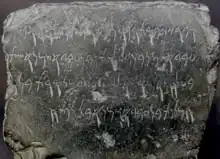Avignon Punic inscription
The Avignon Punic inscription is a Punic language inscription found in the Champfleury area of Quartier Ouest of Avignon in 1897, by a builder digging a trench 2-3 meters deep on the boundary of a property. It was first announced by Mayer Lambert.[1]

The Avignon Punic inscription
It is currently held at the Musée d'archéologie méditerranéenne in Marseilles. It is known as KAI 70 and RES 360
It is considered to originate from Carthage.
Inscription
(1) QBR ZYBQT HKHN[T L]RBT ... BT (This is the) grave of ZYBQT, the pries[tess of (the)] Lady... daughter of (2) ʿBDʾŠMN BN BʿLYTN BN ʿBDʾŠMN ʾŠT 'Abd-Eshmun, son of Baalyaton, son of 'Abd-Eshmun; wife of (3) BʿLḤNʾ MQM ʾL[M BN] ʿBDMLQRT BN Baalhanno, (the) servant (of the) go[ds, son of] 'Abd-Melqart, son of (4) ḤMLKT BN ʿBDʾŠMN ʾBL LPTḤ Himilco, son of 'Abd-Eshmun. Do not open this.
Gallery
Bibliography
- Berger Philippe. Annonce de la découverte d'une inscription phénicienne à Avignon. In: Comptes rendus des séances de l'Académie des Inscriptions et Belles-Lettres, 41e année, N. 6, 1897. p. 672. DOI : https://doi.org/10.3406/crai.1897.71073
- Clerc Michel. Note sur l'inscription phénicienne d'Avignon. In: Comptes rendus des séances de l'Académie des Inscriptions et Belles-Lettres, 42e année, N. 3, 1898. pp. 446-452. DOI : https://doi.org/10.3406/crai.1898.71205
References
- Berger Philippe. Annonce de la découverte d'une inscription phénicienne à Avignon. In: Comptes rendus des séances de l'Académie des Inscriptions et Belles-Lettres, 41e année, N. 6, 1897. p. 672. DOI : https://doi.org/10.3406/crai.1897.71073
External links
This article is issued from Wikipedia. The text is licensed under Creative Commons - Attribution - Sharealike. Additional terms may apply for the media files.



